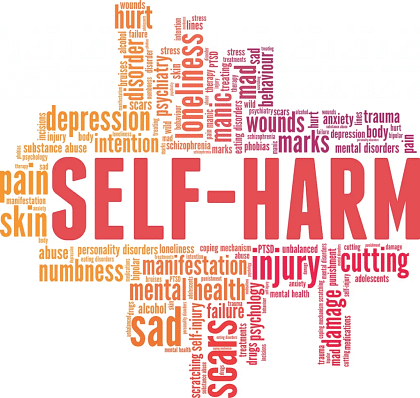Non-Suicidal Self-Injury (NSSI), also known as self-harm, self-injury, or self-mutilation, is the intentional and direct harming of one’s own body tissue to ease psychological or emotional pain without the intent of committing suicide. In addition to the severe negative psychological impacts of self-harm, this behavior can also have physical consequences, such as infection, scarring, and even unintentional death in severe cases.
It is important to be aware of the signs and risk factors associated with self-harm in order to provide appropriate treatment and support for individuals who engage in this behavior. Risk factors for self-harm include a history of abuse or trauma, a lack of social support, and the presence of certain mental health conditions such as depression, anxiety, and personality disorders. Warning signs of self-harm include unexplained cuts, bruises, or burns on the body, frequent wearing of long sleeves or pants to cover up injuries, hoarding of sharp objects or other tools that could be used for self-harm, and making statements about wanting to hurt oneself. If a mental health professional suspects that a patient is engaging in self-harm, it is important to address the behavior calmly, directly, and openly.
I have identified the five most common reasons why teens self-harm. (S.C.A.R.S) I initially created this acronym for my own memory purposes only later to discover the benefits to my clients as well as other clinicians.
S.C.A.R.S.
Self-expression:
Key quote: ”I don’t know what I feel, I just know the scars represent the pain I feel on the inside”.
Although some clients may be resistant and avoid opening up about reasons for their self-harm, sometimes when a patient says “I don’t know”, I’ve discovered oftentimes they really don’t know, and therefore need help with finding the words to identify and articulate their reasons. This is beneficial for patients to identify and articulate their reason(s) for self-harm and for the clinician to hear and understand so they know how to better help.
Often when there is uncertainty about how to express reasons for self-harm, alexithymia comes into play. Alexithymia is a condition in which individuals struggle to put words to their thoughts and emotions. However, by providing the 5 most common reasons others self-harm, (S.C.A.R.S.), patients can have the opportunity to identify which reasons align with their own personal experience or offer a starting point for further clarification and new opportunities for therapeutic intervention.
Control:
Key quote: ”I self-harm because it’s the only thing in my life I can control”
Quotes like these are usually related to parent(s), but can also be indicative of a lack of peer connection or support. A person may self-harm in order to exert control over overwhelming emotions, situations, or even others. When a patient feels out of control, self-harm provides an immediate sense of control and distracts from the emotional and psychological pain they may be experiencing in their extenuating circumstances.
Attention:
Key quote: ”Why can’t everyone see how much I am hurting”
Attention-seeking behavior is another motivation for self-harm. While it is important to understand that many do not self-harm for attention, (and may instead be doing it as a means to cope or survive), it is also important to note that those who self-harm for attention are still at high risk. Keep in mind that teens are growing up in a world with increased competition for attention through the internet and social media. Needing attention is a byproduct of being human; however, demanding that attention through self-harm is maladaptive and destructive on many fronts. Lastly, accusing someone of self-harming for attention usually backfires causing the patient to want to self-harm even more to prove a point to themselves or others. Attention-seeking self-harm just requires a different treatment approach. (More on this in another article)
Regulation:
Key quotes: ”When I cut, it releases all the stress, it’s like I can breathe again” (Anxiety)
“When I cut it helps me to feel alive” (Depression)
Self-harm can also help the patient regulate mood and emotions, particularly in individuals with high anxiety or depression. For those with anxiety, self-harm can serve as a release for overwhelming feelings and stress. Similar to a balloon overfilled with air, patients describe the severe need to release emotional pain through self-harm to bring them down to a more manageable mood state. For those with depression, self-harm serves as a means of “feeling something”, as depression is often described as feeling sad, numb, or apathetic. Therefore self-harm provides a rush of endorphins from injuring body tissue that in and of itself can become progressive and addictive without proper intervention.
Self-punishment:
Key quote: ”I cut because I deserve to be punished”
Self-harm can also be a form of self-punishment, usually prompted by severe feelings of shame and guilt that eventually leads to self-loathing and hatred. Helping patients understand the distinction between mistakes and failure is essential in helping them develop healthier coping skills and a more balanced self-image. Cognitive-behavioral therapy can be very useful by helping the patient to identify similar negative and distorted thought patterns and create opportunities for new perspectives for themselves and their circumstances.

Self-harm Treatment
Helping patients to articulate and express emotional pain through counseling, journaling, music, art, emotional support from loved ones, and even physical activity can provide some relief and reduce the need to self-harm. Also, formulating a personal safety strategy that includes alternatives to self-harm as well as whom to reach out to for support can also be very beneficial. When it comes to treating individuals who engage in self-harm, the most common evidence-based approaches include cognitive-behavioral therapy (CBT) and dialectical behavior therapy (DBT). Both of these therapies have been shown to effectively reduce self-harm behavior and improve overall emotional regulation. Both approaches involve working with the patient to develop coping skills and strategies for managing difficult emotions in a healthier way. Medications may also be helpful and used in conjunction with therapy to help manage symptoms of depression, anxiety, or impulsivity that may contribute to self-harm behavior.
In conclusion, self-harm is a serious issue that requires appropriate treatment and support for individuals who engage in this behavior. In some severe cases, hospitalization may be necessary to ensure the patient’s safety and provide a more intensive treatment strategy especially when the self-harm behaviors are accompanied by significant suicidal ideation or past attempts. Understanding the source of the self-harm behavior is essential in developing effective treatment plans and the necessary tools for individuals to cope with their emotional and psychological pain in a healthier way.
Christian Hill, MA, LPC
Christian Hill Counseling
christianhillcounseling.com




